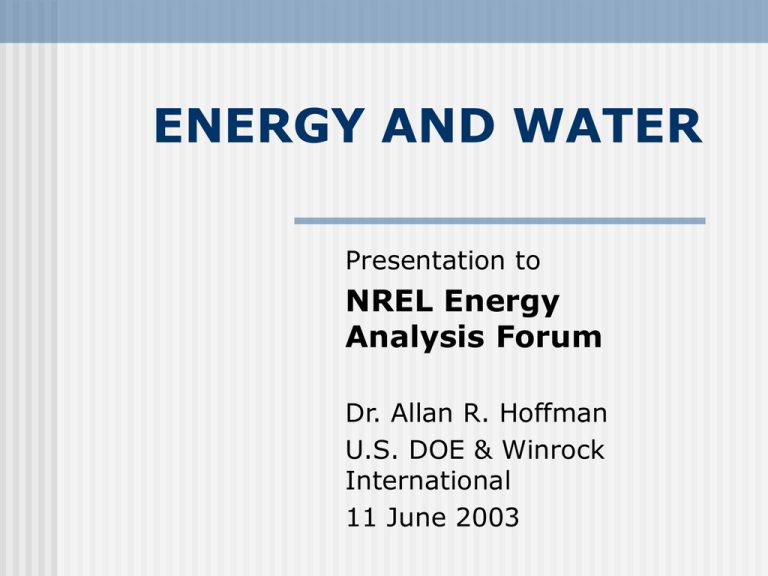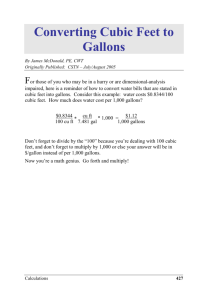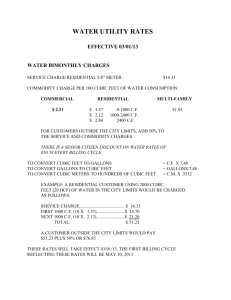energy and water - Knowledge on Line
advertisement

ENERGY AND WATER Presentation to NREL Energy Analysis Forum Dr. Allan R. Hoffman U.S. DOE & Winrock International 11 June 2003 WATER SECURITY Water security is the ability to access sufficient quantities of clean water to maintain minimal standards of food and goods production, sanitation and health The Water-Energy Nexus Central to addressing water security issues is having the energy to extract, transport, manage, treat and desalinate water resources. Water and energy issues are inextricably linked. The Role of Water Water has always been mankind’s most precious resource. There are no substitutes, and the struggle to control water resources has shaped our political and economic history. The Role of Water (continued) Population growth and economic development are driving a steadily increasing demand for new clean water supplies. Water is increasingly recognized as the key environmental issue of the 21st century and the key to poverty reduction. What are the basic facts about global water supply? The earth is a water-rich planet, with the total water supply estimated at 328 million cubic miles. Each cubic mile contains more than one trillion gallons. Of the 328 million cubic miles, 317 million can be found in the oceans (97%) Basic Supply Facts (continued) Another 7 million cubic miles is tied up in icecaps and glaciers, and 3.1 million in the earth’s atmosphere Ground water, fresh water lakes, and rivers account for just over 2 million cubic miles of fresh water Basic Supply Facts (continued) The net result is that 99.7 percent of all the water on earth is not available for human consumption. Of the remaining 0.3 percent much is inaccessible. The vast majority of water for human and animal consumption, much less than 1 percent of the total supply, is stored in groundwater. Water and Conflict Water is not distributed uniformly around the globe, and has been a source of tension wherever water resources are shared by neighboring peoples. Globally, there are more than 250 water bodies shared by more than one country. SOME INTERESTING PERSPECTIVES “The next war in the Middle East will be over water, not politics.” (Boutros BoutrosGhali, Secretary General, United Nations) “The only matter that could take Egypt to war again is water.” (Anwar Sadat, President of Egypt) “Water is the one issue that could drive nations of the region to war.” (King Hussein, Jordan) “Many of the wars in this century were about oil, but wars of the next century will be about water.”(Ismail Serageldin, Vice President, World Bank) How Is Water Used Today? Water use is increasing everywhere. World water demand has more than tripled over the past half century. On a global basis, approximately 70% of all available fresh water is used for agriculture. Africa: 88% Europe: 33% USA: 39% How Is Water Used Today? (continued) Over pumping of groundwater by the world’s farmers exceeds natural replenishment by more than 160 billion cubic meters per year. Water shortages now plague almost every country in North Africa and the Middle East What are the sanitation and health impacts of limited water supplies? Over a billion people today lack access to clean drinking water in the developing world, and nearly 2.5 billion lack access to adequate sanitation services. These numbers will grow in the years ahead. Water-related diseases are a growing human tragedy, killing more than 5 million people each year. Sanitation and health impacts of limited water supplies (continued) Every day, easily prevented diarrheal diseases cause some 6,000 deaths, mostly children under 5. Diarrheal diseases have killed more children in the past 10 years than all the people lost to armed conflict since World War II. About 60 million children annually reach maturity stunted due to severe nutrient loss and complications from multiple diarrheal episodes. Implications For U.S. Strategic Interests Shortages of water can lead to conflict in many parts of the world where water is a transboundary issue, creating national security problems for the United States Water allocation can be a vehicle to engage regional parties in constructive dialogue Sustainable global economic development is major U.S. foreign policy goal. Water and energy are the critical elements of sustainable development. U.S. experience with water resources and their effective management leads the world. Worldwide market in water technologies estimated at $300 billion in the next decade. How is Water Used in the US? Total fresh and saline withdrawals: 402 billion gallons/day Categories of use: Irrigation: 39% Thermal power plant cooling: 38% Residential: 8% Commercial: 3% Industrial: 8% Livestock: 2% Other public use: 2% (Note: latest available data is in USGS Circular 1200: “Estimated Use of Water in the United States in 1995”) U.S. Water Supply Problems Chemical contamination of surface and groundwater, as caused by agricultural, industrial and defense related activities over the past century has been recognized as an important and widespread problem Biological contamination of drinking water, often associated with isolated septic tank or wastewater discharges, has received more attention recently and is now the subject of important changes proposed for U.S. drinking water regulations. U.S. Water Supply Problems (continued) Sea water desalination is being implemented in Tampa, Florida as part of a master plan to provide new water (10% by 2008) to a region whose groundwater resources can no longer supply the growing urban demand. The Ogallala fossil water aquifer in the Central Plains, with no effective recharge, is being depleted by agricultural and urban extraction. U.S. Water Supply Problems (continued) Reduction of CO River water allocated to CA, resulting from inability of competing urban, agricultural and environmental interests to agree on a conservation plan to achieve the same reduction. Increasing number of water disputes in the eastern part of the U.S. VA vs. MD VA vs. NC GA vs. FL vs. AL U.S. Water Supply Problems (continued) Cooling water for thermal (fossil, nuclear) power plants is becoming a serious problem. The increasing age of much of the U.S. water supply and distribution system will require massive rehabilitation investments in the coming decades (recently estimated at $800 billion to $1 trillion). How is the world responding to the global problem? A number of voices have sought to sound the alarm for more than a decade. World Water Forums (1997,2000,2003) UN Millennium Summit (2000) World Summit on Sustainable Development (2002) International Year of Freshwater 2003 New UN Decade of Water? Energy Needs of Water Services Energy is required to: • lift water from depth in an aquifer • pump water in pipes • treat waste water • desalinate brackish or sea water Globally, commercial energy consumed for delivering water is more than 26 quads, 7 percent of total world consumption. A considerable amount of water is also delivered by utilization of human energy – e.g., use of treadle pumps and water transport by women and children. Water-Energy Use in California: An Interesting Example Energy demand associated with water use in CA is high for three reasons: most of demand is located at considerable distance from source water is heavy and moving it is energy intensive water used for consumption must be treated, another energy intensive process Annual water consumption is over 40 million acre-feet (one acre-foot = 326,000 gallons) Energy required annually to pump and treat water exceeds 15,000 GWh, approximately 6.5% of total electricity used in the state per year Water-Energy Use by Power Plants Cooling water for thermal power plants is the second largest user of fresh water in the U.S., second only to water used for agricultural irrigation Estimated use is 190 million gallons per day A 500 MW closed-loop plant requires 7,000 gallons per minute (10.1 million gallons per day) Energy Needed to Lift Ground Water Power = (water flow rate) x (water density) x (head) Example: Lift water from a depth of 100 feet at a flow rate of 20 gallons/minute (0.045 cubic feet/sec), assuming an overall pump efficiency of 50% Power = (2) x (0.045cfs) x (62.4lb/ft3) x (100ft) = 562 ftlb/sec = 1.0 HP Energy Needed to Transport Water Depends on the diameter and length of pipe used In general, use pipe where water velocity is 3-5 feet/sec and water pressure in pipe stays in nominal range Power = (water flow rate) x (water density) x (H + HL) H is lift of water from pump to outflow (positive if pumping uphill and negative if pumping downhill), and HL is the effective head loss from the water flow in the pipe: • • • • • • HL = (F) x (L/D) x (V2/g) F = friction coefficient (from table) L = length of pipe D = diameter of pipe V = water flow rate g = acceleration due to gravity (32.2 ft/sec2) Energy Needed to Transport Water (continued) Example: Move water uphill 100 feet at 3 feet per second through a pipeline that is 1 mile long (5,280 feet) and 2 inches (0.167 feet) in diameter (F=0.025). Flow rate is 29.5 gpm (0.066 cfs). HL = (0.025) x (5,280 ft) x (1/0.167) x (32) x (1/32.2) = 221 ft Power = (2) x (0.066) x (62.4) x (100 + 221) = 2,644 ftlb/sec = 4.8 HP Energy Needed to Treat Water Most water treatment options require energy levels of 2-3 feet of head. At a given flow rate, you can use the first example (slide # 25) to calculate the power required. This number would cover options such as simple filtration or ion exchange. An operation such as ozonization is more dependent on water quality and can require more energy. Average energy use for water treatment drawn from Southern California studies: 652 kWh/AF Note: in many remote parts of the world, treatment must be very basic and inexpensive. This requires a different approach to treatment than implied above. Energy Needed for Desalination Reverse Osmosis: Pressure (200-600psi) applied to intake water, forcing water through semi-permeable membrane. Salt molecules do not pass through membrane. Product water is potable. On average, energy (electrical) accounts for about 40% of total cost. 5,800-12,000 kWh/AF (4.7-5.7 kWh/m3)* Distillation: Intake water heated to produce steam. Steam condensed to produce product water with low salt concentration. Energy requirements for distillation (electrical + thermal) are much higher than for reverse osmosis. 28,500-33,000 kWh/AF (23-27 kWh/m3)* ----------------------------------------------------------------- * Does not include energy required for pre-treatment, brine disposal and water transport. Implications for Global Energy Supply It is now widely recognized that water and sanitation are inextricably linked to the eradication of poverty and the achievement of sustainable economic development As a result, the UN has adopted two related Millennium Development Goals: reduce by half, without access reduce by half, without access by 2015, the proportion of people to safe drinking water by 2015, the proportion of people to basic sanitation Implications (continued) Today more than 1 billion people lack access to safe drinking water (17%) and nearly 2.5 billion lack access to adequate sanitation (41%). Estimated world population in 2015: 7.2 billion In order to reach the Millennium Development Goals: 1.7 billion more people will need to be supplied access to safe drinking water 2.2 billion more people will need to be supplied access to basic sanitation These are large numbers, and the challenge to reach the Millennium Development Goals will be immense. Energy System Implications The kind of energy system chosen to provide water for drinking and sanitation will be a function of local circumstances: What kind of water resources are available, locally and at a distance (local wells, streams, lakes, aquifers, water that can be piped from a distance)? What is the quality of those resources, and what treatment will be required to make the water safe to use(fresh or brackish water, pollution level and nature of pollutants)? What energy resources are available(grid, diesel, renewable,human)? What financial resources are available to provide the needed water infrastructure and related energy needs What level of training is needed to maintain water and energy systems? Concluding Remarks The problem of global water security is already serious and is growing more serious each year Global water security issues impact U.S. strategic interests World attention is finally beginning to focus on water security issues The U.S. is not immune to water security problems Much can be done to address the growing crisis It will take time and lots of resources Concluding Remarks Considerable effort must be expended to identify and characterize water resources, and design supply systems appropriate to local circumstances Water issues cannot be separated from energy issues Careful effort must be expended to identify appropriate energy options needed to meet water security needs A major analytical effort is needed to identify the steps needed to meet the Millennium Development Goals Achievement of these goals will still leave billions of people without water security.









